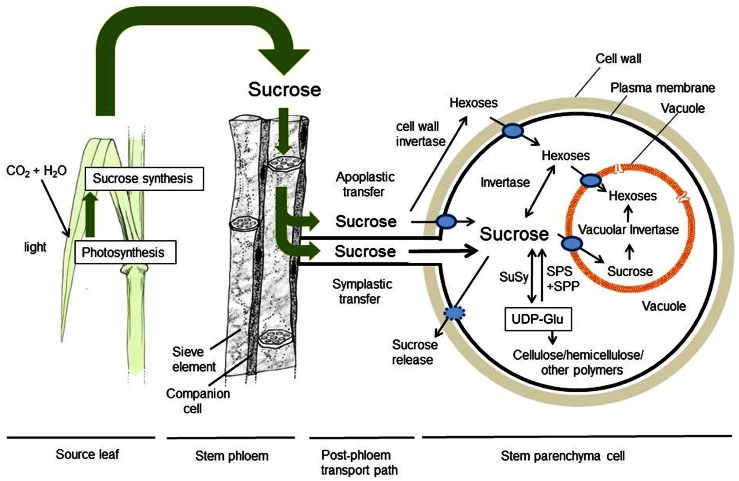FIGURE 1.
Process diagram for sucrose movement and metabolism in sugarcane from its synthesis in source leaves to its deposition in stems. Sucrose movement is shown with green arrows, and its subsequent metabolism and compartmentalization with narrow black arrows. Transporters are shown with blue ovals, cell wall is designated with a wide tan circle, and the vacuole is shown in orange. Sucrose synthesized in photosynthetic leaves is translocated in phloem to stem parenchyma cells, where its post-phloem transfer can follow two paths: symplastic (through plasmodesmata, as thought to predominate in the mature sugarcane internodes) and/or apoplastic (through the cell wall space considered a possible contributor earlier in sugarcane stem growth). Sucrose can move unaltered to storage parenchyma by either path, but apoplastic transfer could involve sucrose hydrolysis to hexoses by cell wall invertase. Both hexoses and sucrose then enter parenchyma cells via transporters. Hexoses can also form from sucrose inside cells by either neutral invertases in the cytoplasm, or vacuolar acid invertases. Sucrose is stored both in vacuoles and cell wall space, the balance between them including transporters and sucrose release to the apoplast. Internal sucrose supplies and partitioning to competing C-sinks also involves balance with UDP-Glu (UDP-glucose), a precursor for cell wall biosynthesis. Key reactions include the reversible SuSy (sucrose synthase), SPS (sucrose-P-synthase), and SPP (sucrose-P-phosphatase) reactions, all having central roles in sugarcane storage cells and operating as shown.

